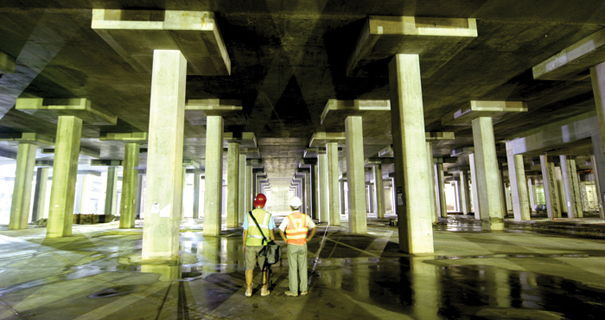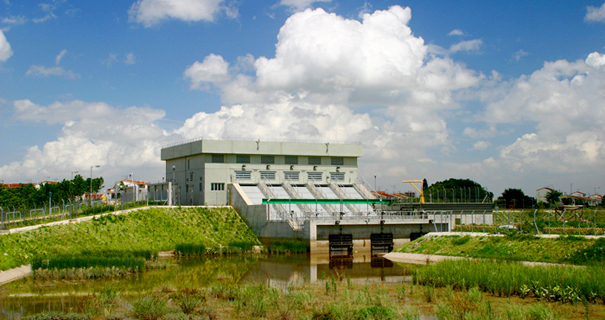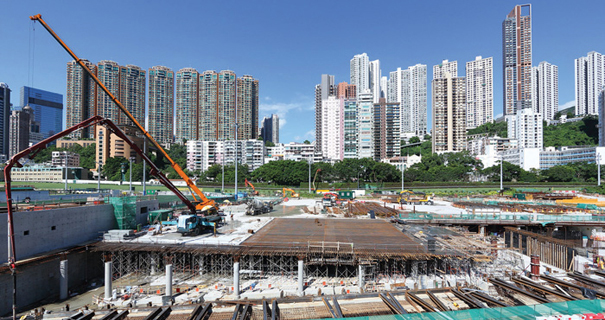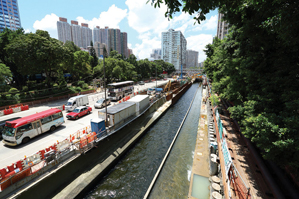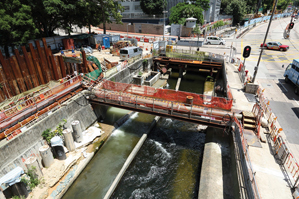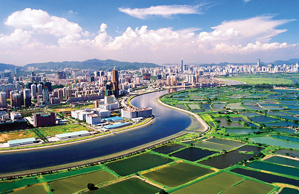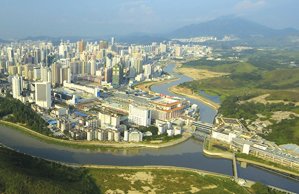With the vision to provide world-class stormwater drainage and wastewater treatment services enabling the sustainable development of Hong Kong, DSD has continued its efforts to improve sewage treatment services and drainage systems to cope with the city’s changing needs.
Overview of Flood Mitigation and Control
To safeguard the general public against flooding, we commit to ensuring the drainage system be built to world-class standard, and be timely and properly maintained. Hong Kong’s annual rainfall in 2013 was over 2,800 millimetres, i.e. nearly about 20 per cent higher than the 1981-2010 mean annual rainfall of about 2,400 millimetres. Nevertheless, the heavy rainstorms, coupled with storm surges during the passage of tropical cyclones, had not caused any serious flooding in the territory.
During the past years, DSD continued to implement flood prevention projects for uplifting flood protection level and reducing flooding risk of various locations. Apart from ensuring proper operation of DSD facilities, we are now focusing our effort to conduct review studies in phases for the Drainage Master Plans, and to formulate strategies to cope with the city’s rapid development and changing drainage needs.
Operation and Maintenance of Existing Facilities
In 2013-14, we continued to carry out routine inspections and regular preventive maintenance works for the stormwater drainage facilities. To ensure proper functioning of the system, we conduct both functional and structural checks on a regular basis. We identify problematic stormwater intakes, drains and watercourses, and carry out maintenance and repair works promptly, especially before and during the rainy season. In the past year, over 2,000 kilometres of stormwater drains and watercourses were inspected.
Emergency and Response
In addition to routine operation and maintenance, we have established the “Emergency and Storm Damage Organisation” (ESDO) to handle emergencies and flooding problems all year round. Under the ESDO, the Emergency Control Centre (ECC) overseen by senior professionals will be activated when the situation warrants. ECC is responsible for coordinating emergency clearance of blocked drains and watercourses throughout the territory, responding to flooding reports, and disseminating information within the Government and, where necessary, to the public.
Stormwater Storage Scheme
Stormwater storage scheme is often adopted when the capacity of the downstream drainage network is inadequate to cope with the increased peak flow rate arising from the developments at upstream areas. When the upstream areas are being developed and the downstream areas have already been fully urbanised, the conventional method of upgrading the existing drainage network at the downstream busy roads will cause severe disturbance to the traffic and public. The principle of stormwater storage scheme is to temporarily store stormwater during heavy rainstorm in an underground storage tank, thus relieving the burden of downstream drainage system. When the stormwater in the downstream drainage system recedes, the stormwater stored in the tank will be pumped out for drainage to regain stormwater storage space for the next rainstorm.
The stormwater storage schemes in operation at Tai Hang Tung and Sheung Wan have successfully reduced the flooding risks in Mong Kok and Sheung Wan respectively. In 2013-14, we continued to maintain the storage tanks and their ancillary equipment to ensure their proper functioning during rainstorms.
Drainage Tunnel
Stormwater drainage tunnel system is constructed to intercept and divert stormwater runoff from upland areas for discharge direct to the sea or river. By using this method, less runoff from upland areas would enter into the existing drainage system in the downstream urban areas. Therefore, the flooding risk of the downstream urban areas could be greatly reduced without resorting to extensive drainage upgrading works that would cause disturbance to the traffic and general public.
DSD currently manages four drainage tunnels, namely Kai Tak Transfer Scheme, Hong Kong West Drainage Tunnel, Lai Chi Kok Drainage Tunnel and Tsuen Wan Drainage Tunnel, with a total length of about 22 kilometres. The commissioning of these drainage tunnels has significantly reduced the surface runoff flowing onto the downstream urban areas including Sheung Wan, Central, Admiralty, Wan Chai, Causeway Bay, Mong Kok, Lai Chi Kok, Cheung Sha Wan, Sham Shui Po, Tsuen Wan and Kwai Chung, hence uplifting the flood protection level of these areas.
Village Flood Protection Scheme
We are now operating 27 village flood protection schemes which provide flood protection to and effectively reduce the flooding risks of 35 low-lying villages. In general, a village flood protection scheme involves the construction of an embankment to separate the existing low-lying village from the surrounding land and to prevent external runoff from entering the village, a flood storage pond for temporary storage of stormwater within the bunded area during heavy rainstorms and a stormwater pumping station to pump water from the storage pond to an outside channel for discharge after rainstorms.
The village flood protection schemes are designed for unmanned automatic operation with telemetry devices. Thus, we have to conduct regular inspections of the floodwater storage ponds and drainage channels, and testing and trial operations of the pumping stations.
Planning, Design and Construction of New Works
Review of Drainage Master Plans (DMPs)
Since DSD’s establishment in 1989, we have completed eight Drainage Master Plan (DMP) studies and three drainage studies covering the floodprone areas of the territory, and implemented a series of drainage projects to enhance the flood protection level of different districts. To cope with the latest developments of the city and the potential impacts on the drainage system brought by climate change, it is necessary to timely review and update the DMPs, and devise strategies to respond to the increasing needs of drainage services. We have progressively commenced studies to comprehensively review the DMPs and evaluate the effectiveness of the completed drainage improvement works with a view to recommending further improvement measures as necessary.
The DMP review studies for Yuen Long and North District and the drainage study for Happy Valley were completed in 2011. We are now reviewing the DMPs for West Kowloon, East Kowloon, Tai Po, Shatin and Sai Kung which are expected to be completed in 2014 and 2015. The reviews for Northern Hong Kong Island will commence in 2014 for completion in 2016 while the remaining review studies are being planned.
Design and Construction of New Works
In 2013-14, we continued to implement the following major flood prevention works:
Happy Valley Underground Stormwater Storage Scheme
Happy Valley Underground Stormwater Storage Scheme is designed to alleviate the flooding risk in Happy Valley and Wan Chai districts. The project comprises the construction of an underground storage tank with a capacity of 60,000 cubic metres, a pump house camouflaged by green sloping ground, a fan room with vertical greening, a twin-cell box culvert of about 650 metres long, and the associated sport pitches re-provision. The main contract works within Happy Valley Recreation Ground commenced in September 2012. The first phase of the underground storage tank is scheduled for completion and commissioning before the rainy season of 2015 while the whole project will be completed in 2018.
Kai Tak River Upstream & Midstream Improvement Works
The Kai Tak River Upstream & Midstream Improvement Works aim to improve the flood protection level of Eastern Kowloon. The project comprises the reconstruction and rehabilitation of the 600-metre upstream section of Kai Tak River from Po Kong Village Road to Tung Kwong Road and the 500-metre midstream section from Tung Kwong Road to Prince Edward Road East, as well as the construction of a new 400-metre long box culvert adjacent to the Kai Tak River. The project commenced in November 2011 for completion in phases from 2015 to 2017.
Shenzhen River Regulation Project Stage IV
Shenzhen River Regulation Project Stage IV is being implemented to improve the flood protection level of the section of Shenzhen River between the estuary of Ping Yuen River and Liantang/Heung Yuen Wai Boundary Control Point. The project comprises the improvement of a 4.5-kilometres Shenzhen River section between Ping Yuen River and Pak Fu Shan. A flood retardation pond will be constructed alongside the river to provide an open storage pond of 80,000 cubic metres. The artificial lake will also enhance the environment by providing habitats for plants and animals. Together with the green elements along the riverbanks, the ecological conditions of the river will be enriched. The advance works of the project, i.e. the realignment of a boundary patrol road alongside the above river section, commenced in March 2012 while the main river training works commenced in August 2013 for completion in 2017.
Commitment to Environmental Conservation and Adoption of "Blue-Green Infrastructure" Concept
To protect the environment, we continue to promote environmental conservation and sustainability in the planning and design of river channels by incorporating the concept of “Blue-Green Infrastructure”. When we design the drainage improvement works to alleviate the flooding risk, we also take account of the preservation of ecological functions of the original watercourses, the rehabilitation of damaged drainage channels, the use of natural materials at embankments and riverbeds, and the conservation of existing habitats.
We believe that a sustainable city should have a drainage system incorporating features designed with the “Blue-Green Infrastructure” concept, “Blue” refers to water bodies while “Green” represents landscaping and greening. The relevant features include flood retention lakes, green roofs, porous pavements, rainwater harvesting system, etc. We are also promoting a more natural drainage system through attenuating the peak runoff at source by provision of appropriate “Blue-green Infrastructure” elements. DSD is devoted to explore the scope of application and how the concept will be better integrated into existing drainage system.
Management of Underground Drainage and Sewerage Networks
DSD currently manages more than 4,000 killometres of underground conduits, comprising sewers and stormwater drains. Many of these conduits have been in service for over several decades and are suffering from aging and deterioration. We have established routine inspection programmes to monitor the conditions of the conduits and will carry out corresponding rehabilitation works as necessary. In 2013-14, approximately 26 kilometres of sewers and stormwater drains were rehabilitated at a cost of about $95 million.
To cope with the anticipated increasing demand of rehabilitation, we commissioned a study in October 2012 to develop a long-term and territory-wide replacement and rehabilitation (R&R) strategy for better management of our underground conduits. We aim at formulating a comprehensive R&R strategy with implementation plan upon completion of the study to enable timely rejuvenation of our drainage and sewerage networks. The viability and relative merits of various advanced R&R technologies are also being studied for adoption with a view to carrying out the works in the most efficient and effective manner. All these initiatives will enable us to develop a systematic and cost-effective approach in maintaining the healthiness and functioning of our networks.








